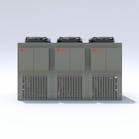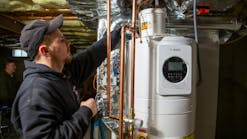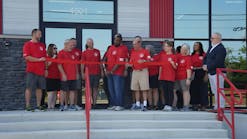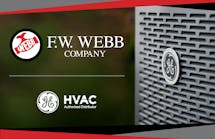We can learn a great deal from market research and consumer trend studies, but here are a couple of certainties when it comes to homeowners and HVAC: They want to spend as little money as possible for their energy costs, they want efficiency and they want their systems to work seamlessly. That's easy. It gets a little more complicated when homeowners try to figure out the right mix of high-efficiency equipment that fits their budgets and the way they live their lives.
So what are some of the trends in high-efficiency HVAC hydronic products and systems? We asked three manufacturers to give us their take on this growing market.
Uponor heats up the radiant market
One of the biggest trends in HVACR is using renewable energy, such as geothermal and solar, to efficiently heat a home. This is particularly true as energy costs continue to climb and a mix of federal and local tax incentives and rebates on renewable systems make them more affordable to a greater number of consumers. Radiant heating can play a big part in enabling a geothermal or solar system to run more efficiently and maximize energy savings.
“For example, high-efficiency geothermal heat pumps operate more efficiently at lower water temperatures,” says Mark Hudoba, Uponor's senior product manager for heating and cooling. Because radiant floor heating systems require lower water temperatures than radiators or forced-air systems, the radiant floor heating system enables the heat pump to operate more efficiently.
Integrating radiant heating with these renewable systems is becoming increasingly popular as a new wave of radiant controls makes it very easy for homeowners to create a comfortable and even temperature exactly where they want it. These controls also increase system efficiency by integrating the heating, cooling, ventilation and humidification systems. One problem that integrated controls solve is simultaneous heating and cooling that can occur when one control system is used for heating and another control is used for cooling.
Uponor's ClimateControl™ Network System is one of the leading radiant controls on the market today. This is a “smart” system that routinely performs two-way communications throughout the network — it can send as well as receive information. Homeowners can also control the system remotely through Internet access, and there's an optional notification system that permits a service contractor to monitor and manage the network online and troubleshoot remotely. Of course, the homeowner can also control the temperature the old-fashioned way via the slim, flush-mount wall thermostat.
Hudoba also says products like Uponor's new Radiant Ready 30E™ and Fast Trak™ are simplified radiant system installation options, which are particularly attractive options for homeowners who want to focus on renovation and remodeling. Hudoba notes that the U.S. new construction market has declined by nearly 75 percent over the past five years, while the retrofit market has remained relatively strong, making these types of products ideal for homeowners who want an easy and cost-effective way to improve the comfort and heating in their homes. While the installation of a radiant floor heating system for a 1,000-square-foot basement may take up to a week, with Radiant Ready 30E and Fast Trak, installations can typically take less than a day.
Page 2 of 4
“Uponor's Radiant Ready 30E is a complete radiant mechanical room in a compact, easy-to-install package that allows homeowners a simple and cost-effective opportunity to add the value, energy efficiency and comfort of radiant to their basements, bathrooms, kitchens and recreation rooms,” Hudoba says. Radiant Ready 30E's preassembled panel includes a boiler, manifold, pump, expansion tank, pressure relief-valve, isolation valves, thermostat and air vent already pre-wired and ready to be installed. The only work required is to connect the tubing, thermostat and electrical power.
Uponor's Fast Trak accompanies the Radiant Ready 30E panel. The Fast Trak knobbed mats provide a faster, easier method for installing crosslinked polyethylene (PEX) tubing in overpour applications for virtually any room in a home. Fast Trak products are available in two models, including a half-inch application that eliminates the need to alter baseboards, moldings or doors.
While products like these are ideal for the retrofit market, they are designed for any type of new construction, from high-end to starter homes. Even as these products capture a greater share of the market, Hudoba says distributors who want to be successful at selling radiant have to make it a core competency. “Focusing on simple systems and leveraging the new Radiant Ready 30E product is an excellent place to start,” he says. “Leveraging radiant training, technical and design services of radiant heating system manufacturers, such as Uponor, will also assist the distributors with developing their knowledge and growing their business.”
Raypak: Tying it all together seamlessly
Raypak, part of the Rheem family of brands, manufactures a range of high-efficiency residential and commercial boilers, pool heaters and spa heaters. Steve Thurlkill, Raypak's national sales manager, credits the influence of European residential technology in the early 1990s with a shift to high-efficiency hydronic systems in North America. Its commercial pool and spa heaters became the biggest segment of high-efficiency products because of their ability to achieve 96 percent to 98 percent operating efficiencies. On the residential heating side, local and federal government incentives helped to normalize that segment of the market, he says. During the past decade, such incentives, including the maximum $1,500 federal tax credit that expired last year, have helped contractors to upsell many high-efficiency products.
Since then, Raypak engineers have developed new materials and methods to build greater energy efficiencies into its HVAC systems and products. At Raypak, product development is an ongoing process, Thurlkill says. “Most of the innovation that we're seeing at Rheem and Raypak is on the electronics and controls side,” he says. While there are only so many ways to build a heat exchanger with water in it, there are a countless number of ways to control and integrate that heat exchanger with everything else in the system. Or, as Thurlkill says, “Tying it all together seamlessly.”
More and more homeowners and building owners today expect to have this seamless integration of HVAC products. They want their water heating, space heating, air conditioning and pool heater integrated through a smart device that can be enabled from a smart-phone or an easy-to-use touch screen within their house. “The people who are buying homes today are very tech savvy and want to see this,” Thurlkill says. Raypak has already incorporated this type of integration within its commercial systems, and it is becoming more integrated into its residential systems. “We're really going to see the most development of this in the next five years — total control integration,” he says.
Page 3 of 4
On the control side, Raypak's TempTracker MOD+ Hybrid Control provides an innovative way to gain energy efficiency from multiple boilers. The TempTracker MOD+ Hybrid Control is capable of switching from condensing boiler lead to noncondensing boiler lead as load demand shifts. This control senses variations in seasonal and daily water temperature requirement to select the proper lead unit. It monitors and displays supply water temperatures on all applications and monitors outdoor temperature when utilizing an outdoor reset mode. The control also easily integrates into the building via a BACnet MS/TP plug-in.
Raypak's new XTherm line of commercial boilers is an example of how the company has re-engineered its systems to get increased energy efficiency while using less space. The XTherm boilers use a finned copper tube exchanger for the near condensing operation, in conjunction with a 316L stainless steel condenser to extract the rest of the heat that brings it to 96 percent thermal efficiency, Thurlkill explains. For the installer and the building owner, the XTherm provides flexible installation, optimal seasonal efficiency and long-term reliability.
Raypak has also developed the XPak line of modulating wall-hung hydronic boilers in sizes 85 and 130 MBTU that have unique features such as modulation with 4:1 turn down, synchronized with a three-speed nonferrous pump, two-section heat exchanger to minimize condensate dwell time and three-inch CPVC, stainless steel or polypropylene vent. These wall-hung boilers also address another issue that consumers and building owners demand: ease of use. Thurlkill says the easy-access controls are extremely user friendly. They also carry an industry-leading 20-year, pro-rated warranty.
One of the big issues that Raypak has worked hard to address is the lack of enough qualified service technicians in the industry as a whole. “Training is definitely a huge, key item, and it's something that Rheem and Raypak are investing heavily in because we know we need to,” Thurlkill says. To reach as many contractors and service technicians as possible, Raypak now takes its training on the road. This includes moving transportable training modules throughout the country.
“It's hands-on training, and it's much more effective,” Thurlkill says, adding that it also allows them to train many more technicians. “You can read about boiler troubleshooting and hear about it, but until you put your hands on a boiler, you're afraid to touch it.”
Thurlkill says Raypak works closely with its distributors and others in local markets to create greater visibility of its products throughout the supply chain. This includes working with energy providers on local marketing initiatives, including counter days, advertising in local media and combined training events for contractors and installers.
Taco: Integration for great efficiencies
As HVAC equipment becomes more and more energy efficient, Taco Inc. is solving the issue of integrating all of this equipment into more intelligent, cohesive systems. Increasingly, professionals are using a mix of greatly more efficient heat generation and cooling devices to maximize comfort and efficiency within homes and buildings.
Page 4 of 4
Each piece of high efficient equipment does a great job on its own, but the challenge is making them work well together so they can deliver the type of energy efficiency that they were designed for. “It's not the hardest thing to install a solar panel on a roof or a mod-con boiler in the basement,” says Mark Chaffee, director of residential marketing, “but how do you integrate it intelligently with the rest of the HVAC system?”
For Taco, this concept of system integration represents the next phase in energy efficiency. With its LoadMatch system, for example, Taco has developed an advanced infrastructure that enables high-efficiency hydronic heating and cooling while delivering better comfort, lower first costs and maintenance and reduced energy consumption. As public buildings, such as schools, universities, government buildings and hospitals look for ways to increase their efficiency, LoadMatch is a means to help them accomplish this goal. “They're more on the cutting edge of becoming greener,” Chaffee says.
A LoadMatch single pipe system is also more efficient in terms of space. Instead of a big mechanical room that requires a number of large pumps and valves, there is only a single pipe — and smaller pumps at the terminal units that only come on when the particular terminal is required for heating and cooling that section. “So you reduce the total horsepower, reduce usage, reduce piping and get a lot more comfort,” he says. “It's design concepts like this that are completely changing the mentality of the way systems are assembled and controlled.
As controls engineers design more energy-efficient HVAC systems, iWorx from Taco Electronic Solutions is a web-based building management, monitoring and control system for larger residential and light commercial markets. “You can easily select and supply the whole design,” Chaffee says. For wholesale distributors, this is an opportunity for them to get involved and work with the engineers or the design-build team to help specify building management control systems so they match up, talk to one another and get the most out of each piece of equipment. It's easily scalable for single locations or multibuilding and multisite installations, and it can integrate forced air and hydronic systems, including geothermal and solar, to ensure smooth communication.
Another great system support tool is FloPro Designer, a complete software program that can do everything from heat loss calculations to a layout of the entire piping and equipment, and it will print a complete bill of materials for the job which the wholesaler can then supply. “This is really something where the wholesaler can get involved to provide design support, system expertise — and include all the equipment which they can then supply,” he says. What makes FloPro Designer such an appealing program is its flexibility, ease of use and it's free.
Chaffee says momentum is accelerating for Taco's energy-efficient products and its integration systems, particularly among those who are in design-build and plan on owning the buildings. With a slow housing market in most of the United States, owners have a greater financial stake in maintaining their buildings and getting the most out of its infrastructure. They're asking more questions about the life-cycle cost of the building. “More people are choosing to do the right things with their systems.”
At Taco's headquarters in Cranston, RI, they're working to ensure that contractors and engineers do right by their customers. They're undertaking a major addition to its headquarters, building a new training and innovation center that will be a showcase for all things hydronic and HVAC. “If there's any possible way you could use a hydronic product or integrate HVAC and hydronics in a building, then we're showcasing it,” Chaffee says. When completed, the center will showcase up to 10 different systems that will allow people from around the industry to see, touch and learn.
Continuing learning is essential — particularly for distributors, Chaffee adds. He says distributors have to develop the mindset that they're selling systems, and not just pieces of equipment. “The knowledge base has to be more involved about how to integrate all of those pieces of equipment into a system for the benefit of their customers and it's our goal to help them achieve this through our products and programs,” he says.
Michael Maynard is a business writer based in Providence, RI. He writes frequently on HVACR, construction and architecture issues. Contact him at[email protected].









